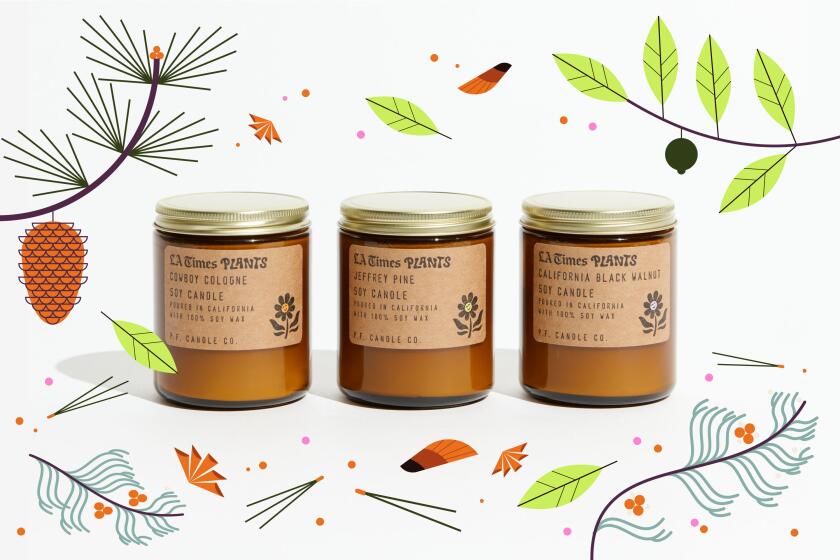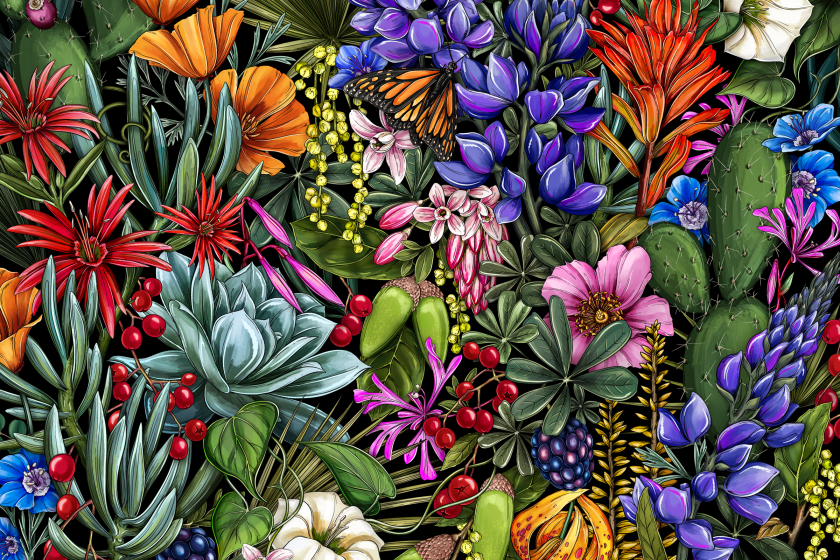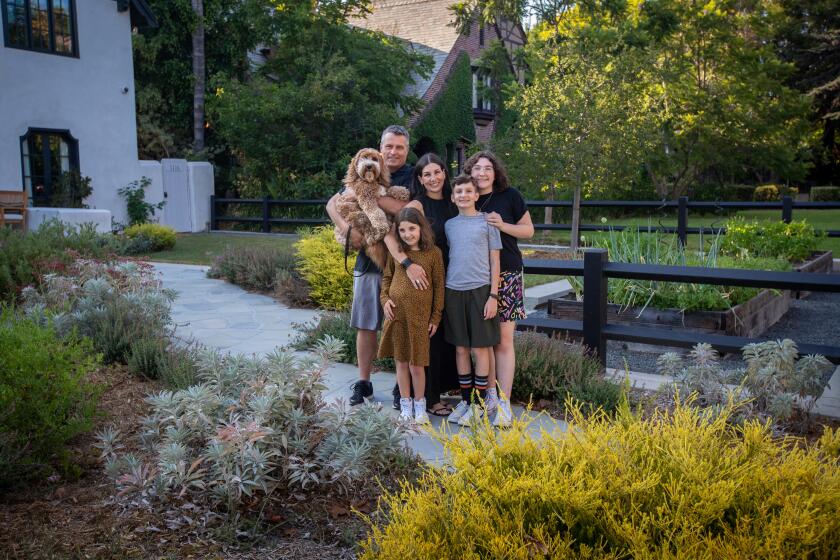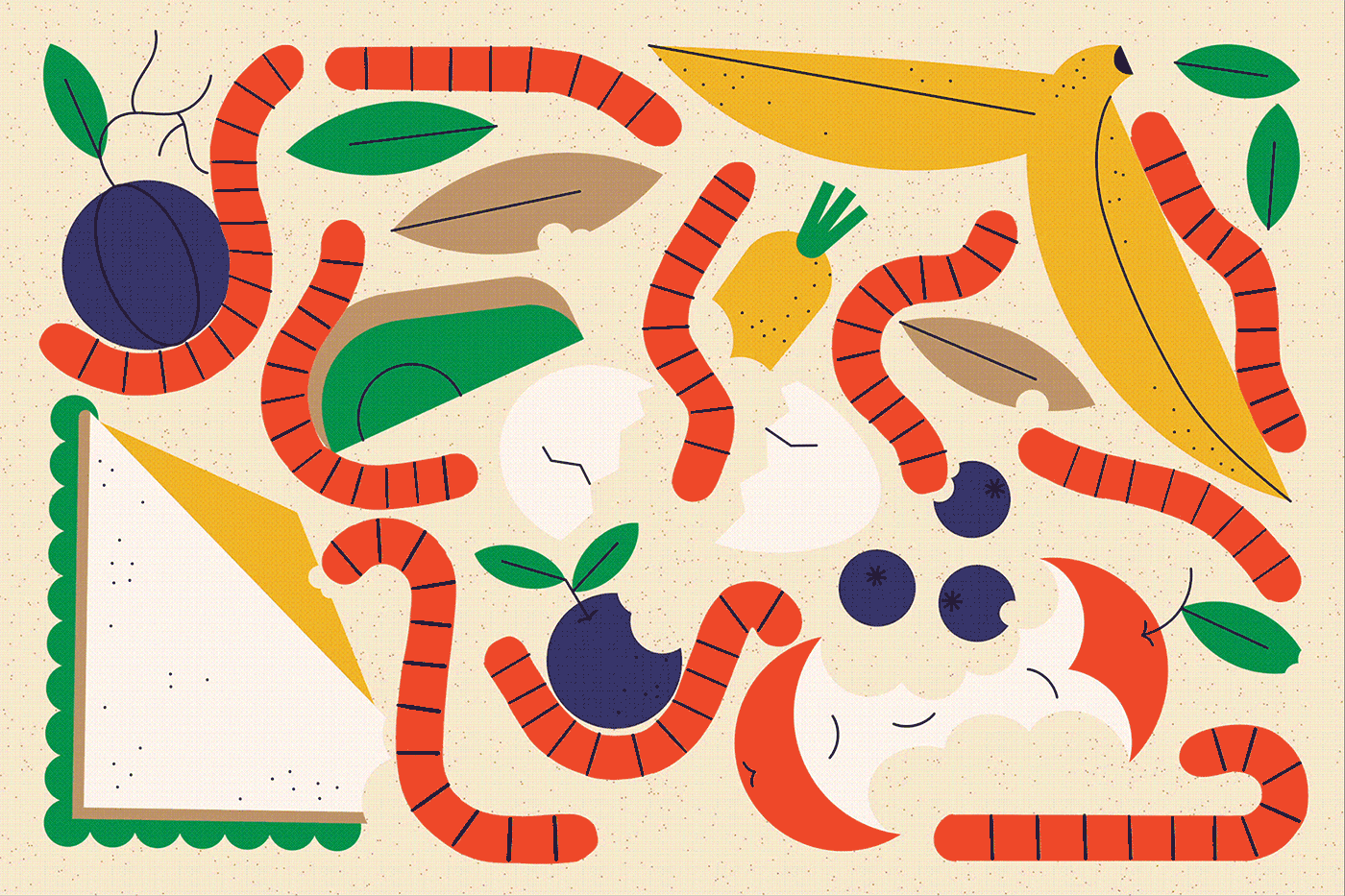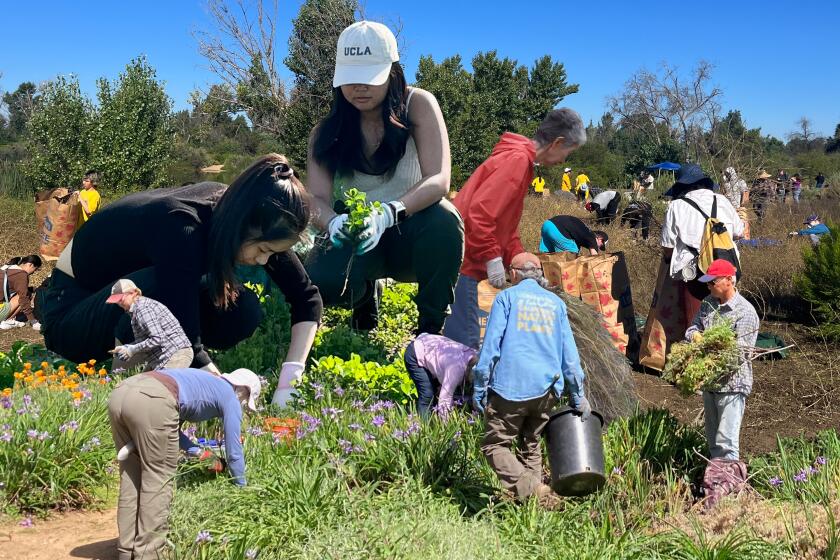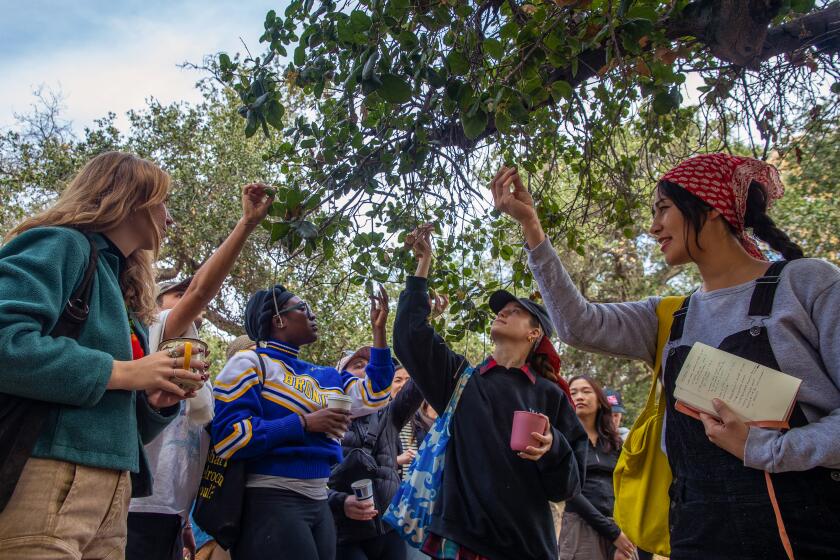California native plants are not our only choice for drought-tolerant landscapes
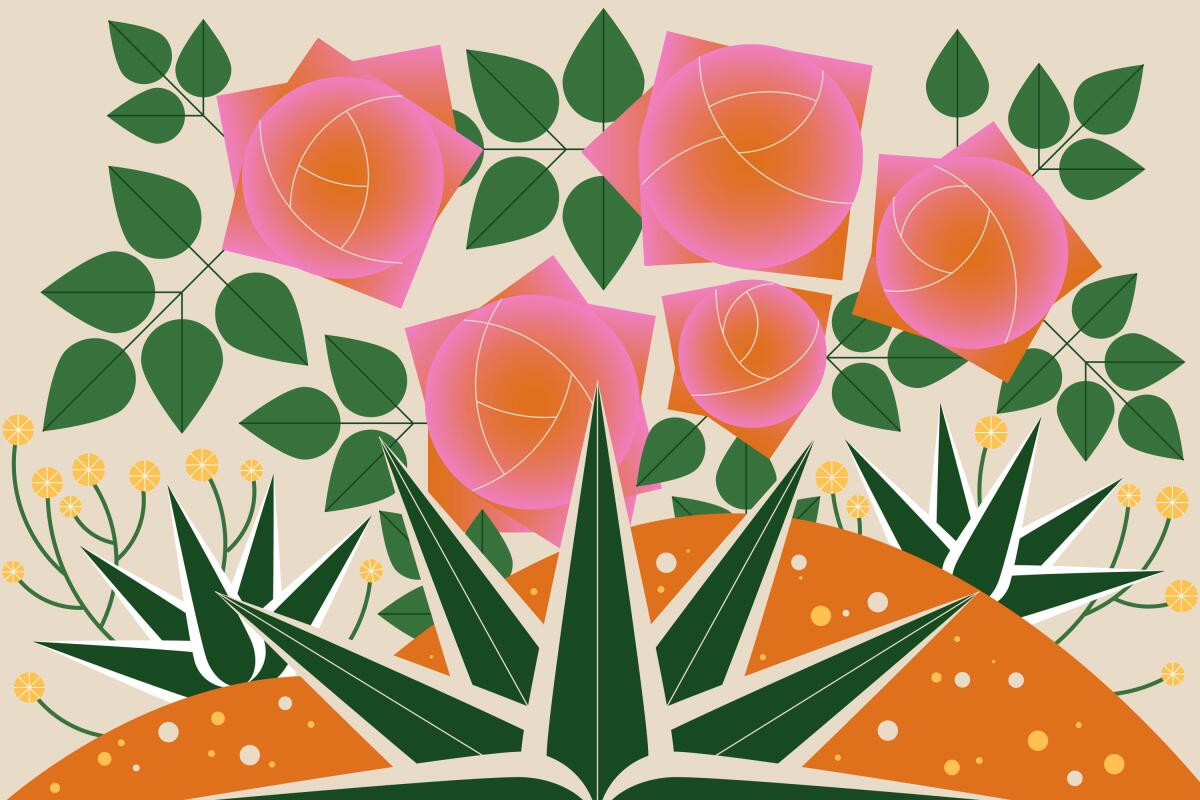
Welcome to the December issue of the L.A. Times Plants newsletter. Yes, I know it’s the holidays. However, we have plenty to keep plant people busy this month.
First, let me share what I learned from wholesale nursery people at the Assn. of Professional Landscape Designers’ annual plant fair at the L.A. County Arboretum: Drought-tolerant landscapes in Southern California are here to stay, but that doesn’t mean all the plants must be California natives.
You’re reading the L.A. Times Plants newsletter
Jeanette Marantos gives you a roundup of upcoming plant-related activities and events in Southern California, along with our latest plant stories.
You may occasionally receive promotional content from the Los Angeles Times.
APLD’s Plant Fair is a chance for wholesale nurseries to show off their new, improved plant varieties to landscape designers in the hopes they’ll include them in future designs. More than half the wholesalers who attended grow a lot of California native plants, but most were pushing non-natives from the world’s other Mediterranean climate regions (which in addition to Southern California-Baja include parts of Chile, the Mediterranean, South Africa and Australia.)
And the good news for small space gardeners is that many of these water-efficient varieties grow well in containers.
Australian natives seemed to get the most love, in part because that region produces so many unique and weirdly wonderful low-water plants that thrive in Southern California, said horticulturist Randy Baldwin, general manager of San Marcos Growers in Santa Barbara.
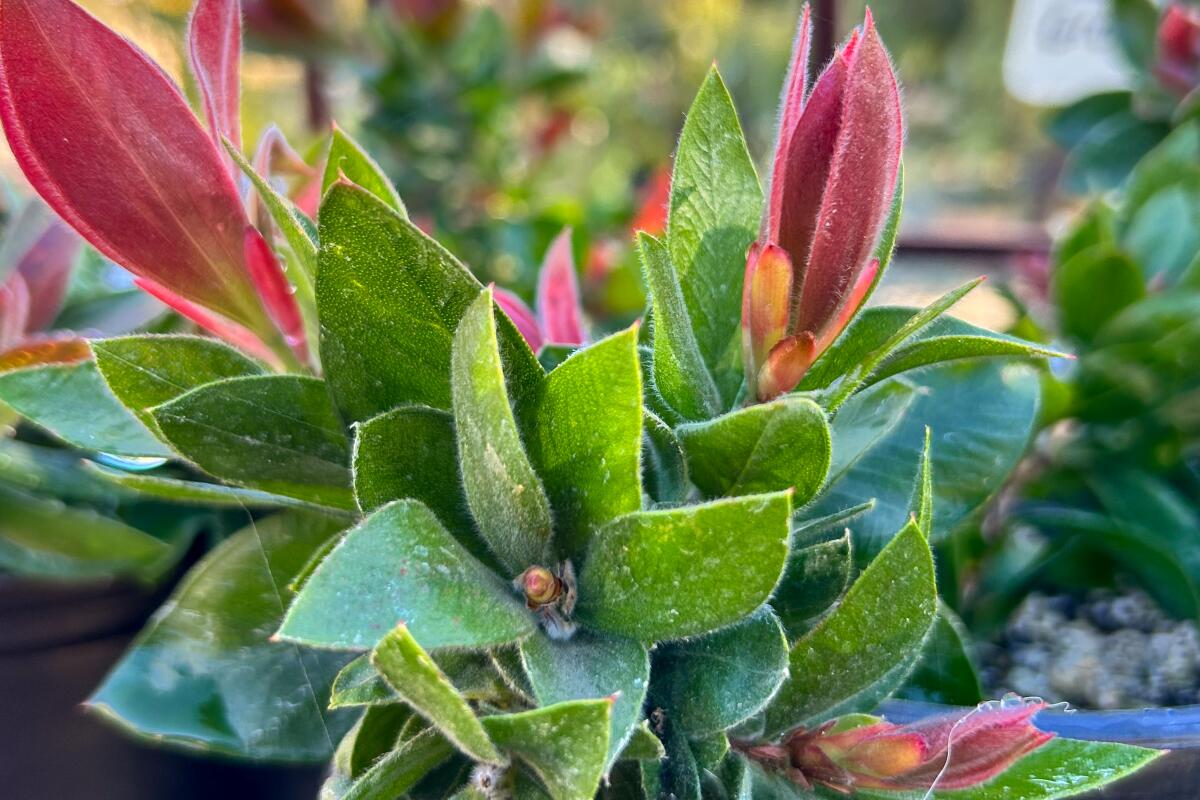
“It’s all about diversity,” said Baldwin, who promoted plants from Mexico and Australia at the conference, even though his nursery is one of the state’s largest wholesale growers of California native plants. “I’m a plant nut and I like plants from Mediterranean climates because they look great mixed in with California natives.”
I talk a lot about native plants, so for the sake of space, I’m not mentioning those offerings here except to note that many were selected to fit more easily into a residential landscape, like more compact varieties of buckwheat. Bulk and spread are a problem with many natives that can crowd out the other plants in your garden. (I’m looking at you, matilija poppy, I’d love to see a compact version of this beauty!)
When I say “new” offerings, I don’t mean recently discovered flora. Think of these introductions as the 2.0 models of plants we’ve seen before, tweaked through careful cultivation to be a better fit for patios and smaller yards.
For instance, one of Baldwin’s favorites is a rare sculptural succulent from Mexico fittingly named the white rhino agave (Agave victoriae-reginae ‘Albomarginata’). .
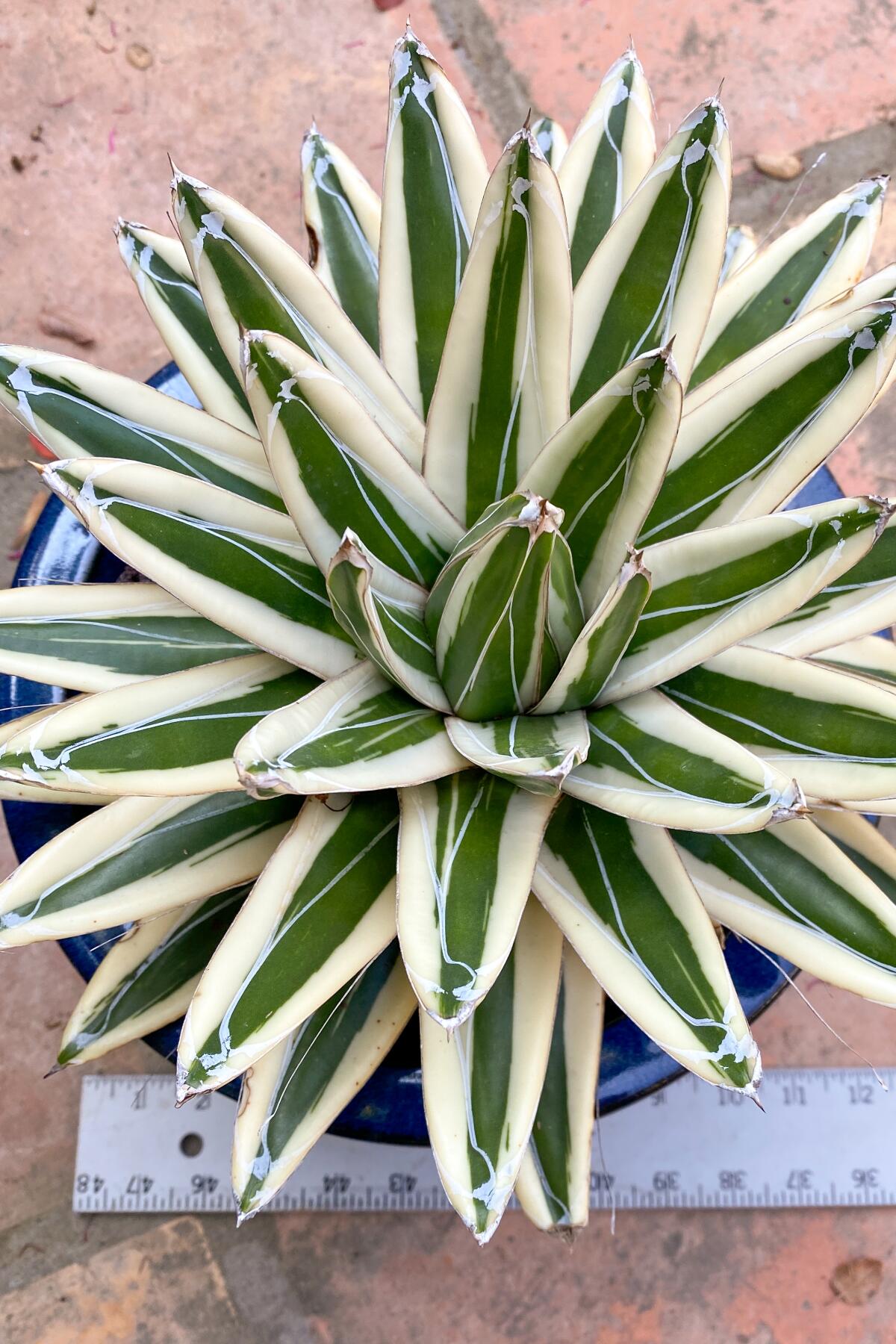
Agaves are nothing new in the SoCal landscape. But white rhino grows slowly and stays pretty small — about a foot tall and no more than a couple of feet wide — so it works beautifully in containers. And once established, these plants do best with little water.
L.A. Times Plants and P.F. Candle Co. introduce a limited-edition soy candle line that celebrates the resilience — and aroma — of California native plants.
Another Baldwin favorite is the twisted desert wattle (Acacia aphylla), a sculptural plant with twisty, deep green branches and little fluff balls of yellow flowers at the tips. He learned about this plant from fellow horticulturist Jo O’Connell, owner of Australian Native Plants in Ventura and the designer of the Australian portion of Taft Gardens in OJai.
O’Connell was also at the fair, with her series of extraordinary flora from down under, like the flame-tipped ground cover pictured above known as Red Rover bottlebrush (Callistemon ‘Red Rover’) that look like wiggly green candles burning brightly on the ground.
The thing about Australian varieties is they rarely disappoint, Baldwin said. “I just think they’re cool plants, unusual, and people rely on me to have good plants, which is why these new introductions count.”
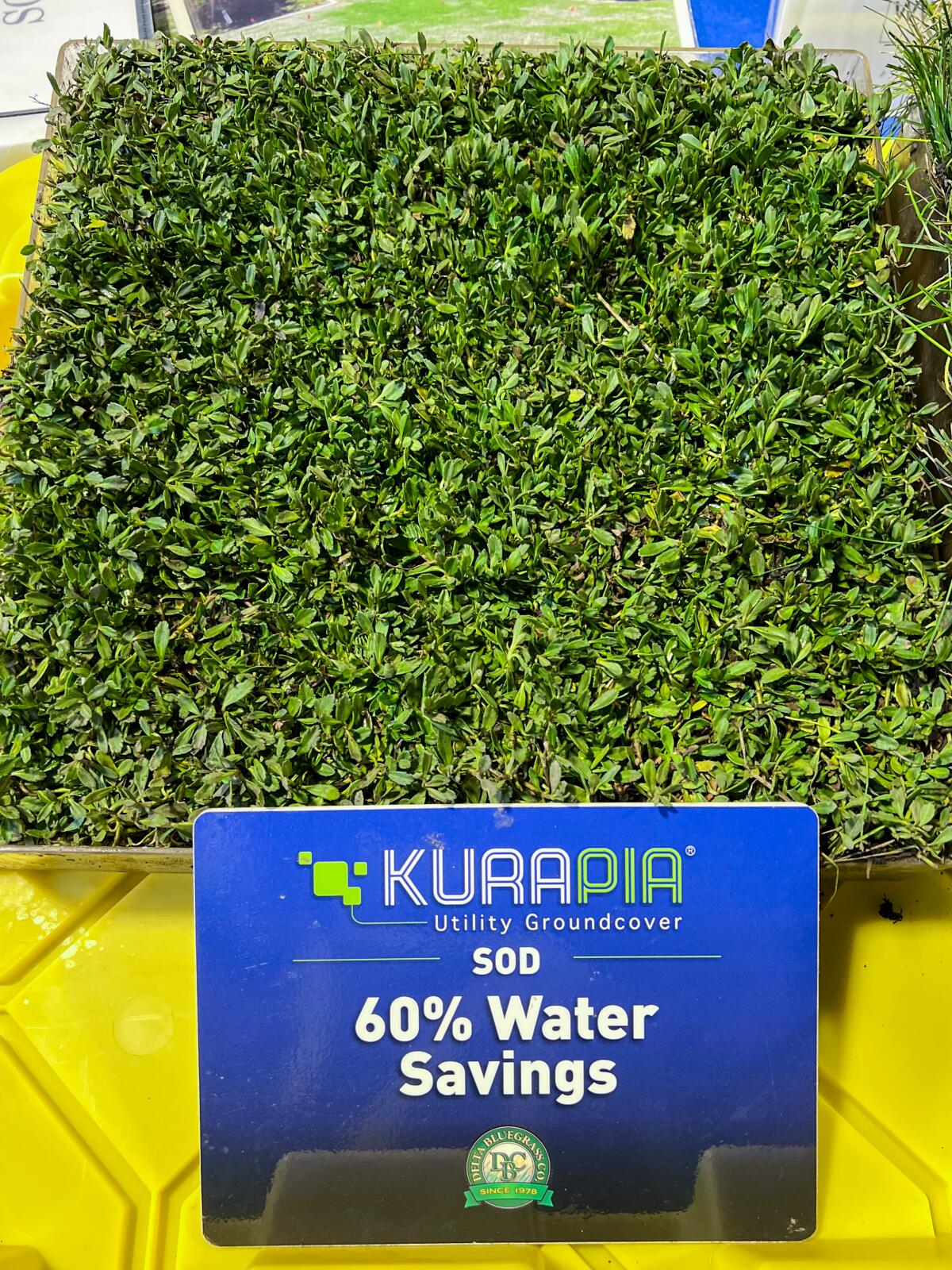
Another 2.0 example is a grass from Japan known as kurapia (Lippia nodiflora), which grows so successfully in Southern California that it’s been considered an invasive weed. But now you can plant a sterile variety sold in rolls of sod that will quickly create a turf-like covering using just a fraction of the water required by traditional lawns, said Robert Sjoquist, director of Soils Solutions, a distributor for kurapia and low-water California native grasses.
Sjoquist said he waters his kurapia lawn in Ventura just a couple times a year (dryer inland areas need to water more often, he said), and mows just once or twice a year. The grass has tiny clover-like flowers attractive to pollinators and grows quickly, smothering weeds. He said it also smothers fires, pointing to a photo of a home in Ventura with a kurapia lawn that survived the Thomas fire. It’s also great for doggies, giving them a cushy place to roll that won’t turn yellow from poo or pee.
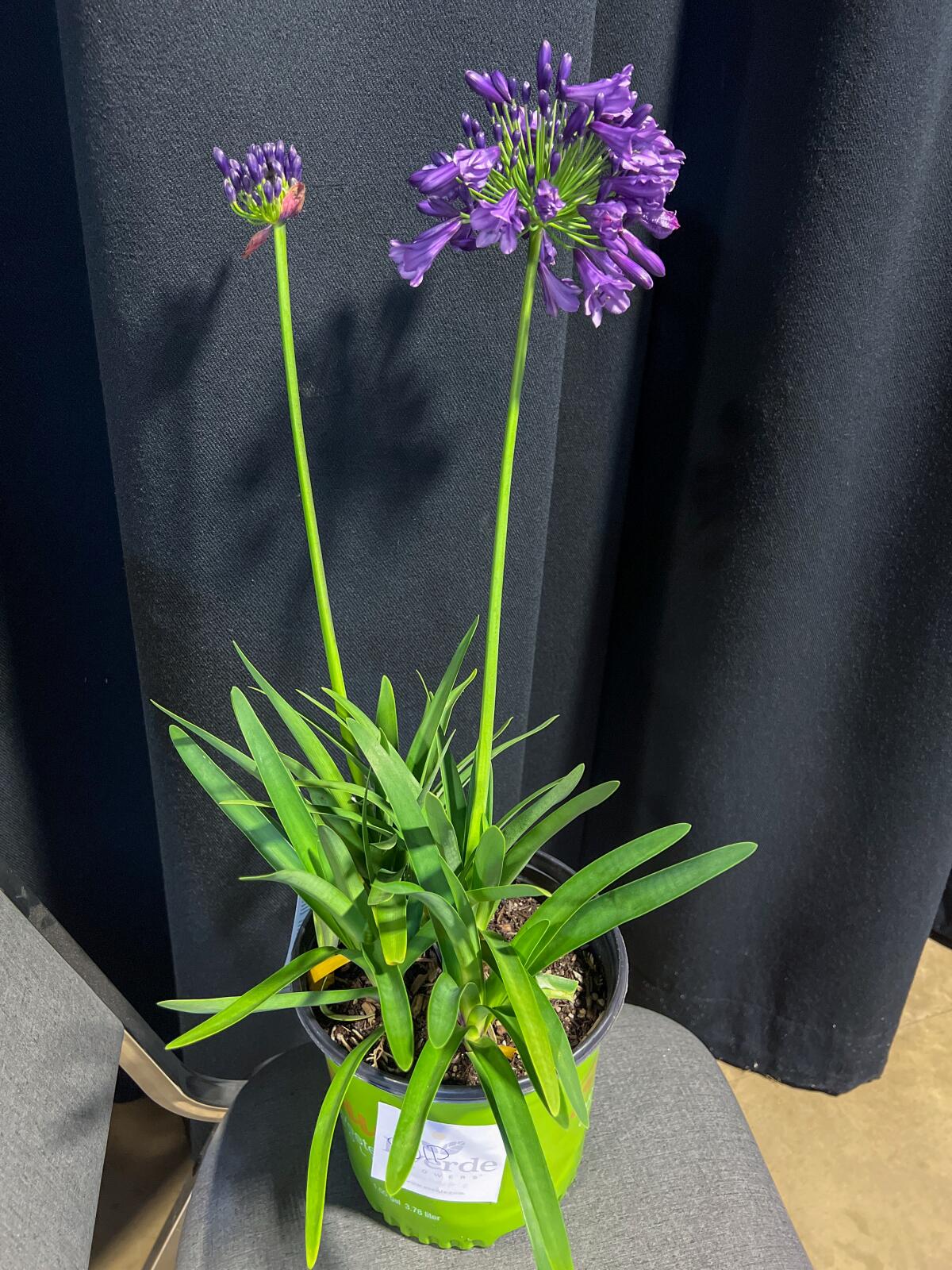
One of the biggest surprises for me was Sunset Plant Collection pushing new versions of buddleia (a.k.a. butterfly bush — historically an overbearing rangy shrub with lilac-like flowers) and agapanthus (sometimes known as lily-of-the-nile), the omnipresent filler plant of my youth.
The agapanthus of old spent 11 months of the year as boring clumps of thick, droopy spear-shaped leaves until they finally sent up stalks of gorgeous sparkler-shaped purple blooms. But these new varieties bloom at least eight months a year, said Sunset horticulturist Janet Sluis. They also have much smaller leaves and are less invasive in the garden.
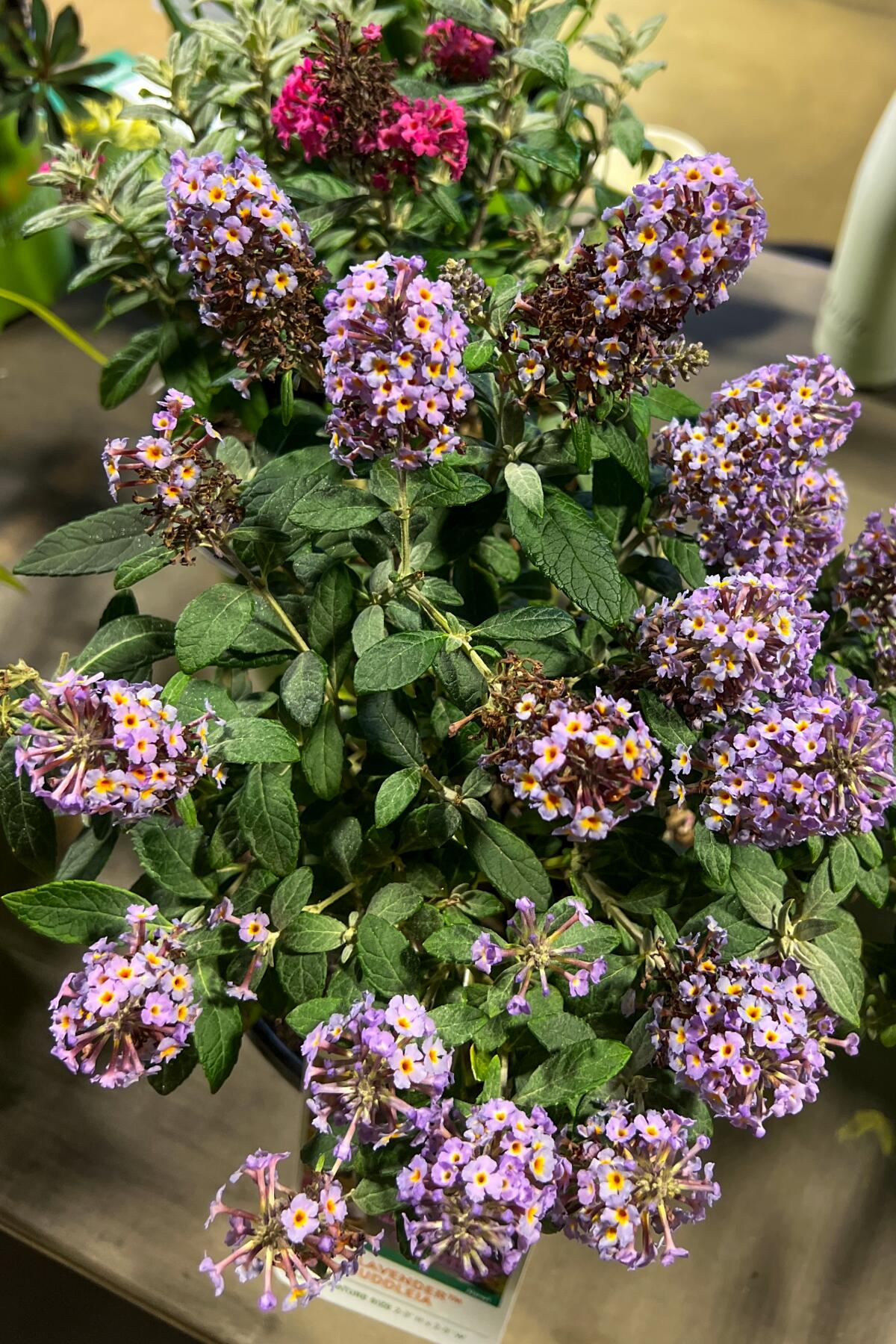
The new Butterfly Candy buddleia, known as Lil Lavender and Lil Raspberry, have also been bred to a more compact size, just 2 to 3 feet tall and wide, and since these plants don’t produce seeds, they’re noninvasive, Sluis said. They work well in containers, and, most importantly, produce pollinator-friendly blooms for months.
“We can’t keep the butterflies off them,” she said. “In California, if you’re looking to make your yard a food source, you need more flowers per square foot. .... We can have both natives and non-natives to satisfy our needs for an ornamental landscape and feeding pollinators.”
Here are the best retail native plant nurseries in Southern California to help you create a habitat for birds and pollinators in your yard or even on a patio.
You can see a detailed list of the plants that were presented at the fair, but here are three more that piqued my interest:
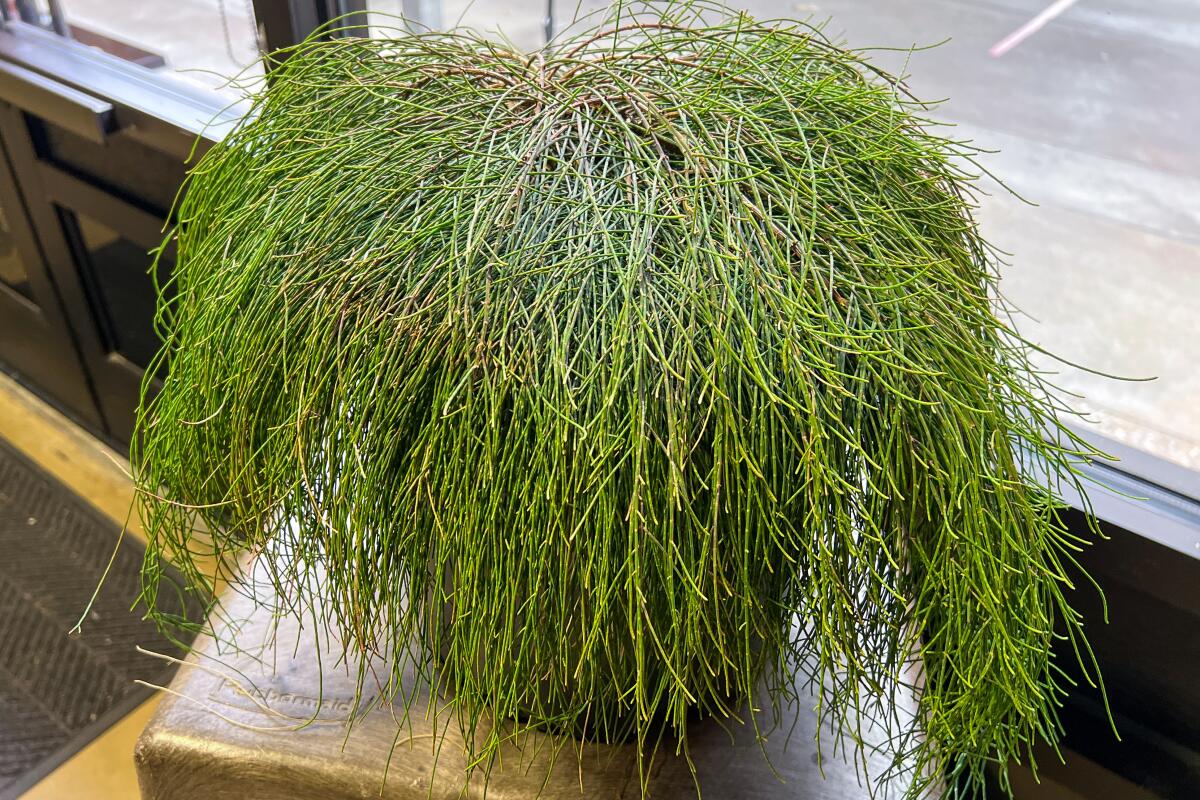
- Casuarina glauca ‘Cousin It’: For all you Addams Family fans, how cool would this Australian evergreen look in a patio pot? With sunglasses? Devil Mountain Wholesale Nursery says this fast-growing ground cover (a.k.a. prostrate swamp oak) is great at crowding out weeds and does well in various soils and temperatures, as well as containers. .
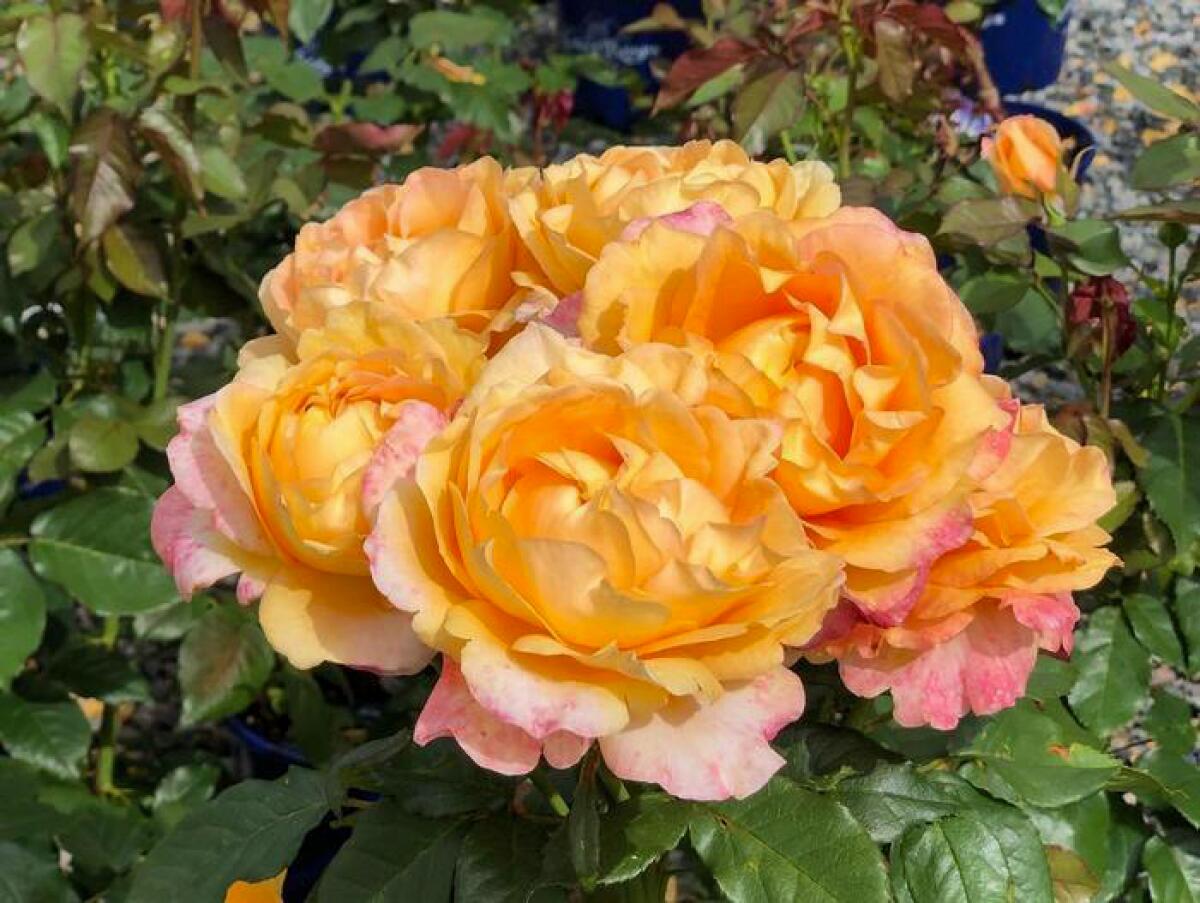
- Maui Sunrise: Roses have a prima donna reputation as high-maintenance water hogs, but Andy Klittich, manager of Otto & Sons Nursery in Fillmore (open to the public), says that’s a bad rap. Yes, roses need some tending to perform at their best, but once established, they need relatively little water, Klittich said. Newer varieties, like Maui Sunrise are fragrant, compact super bloomers, making them excellent choices for container growing.
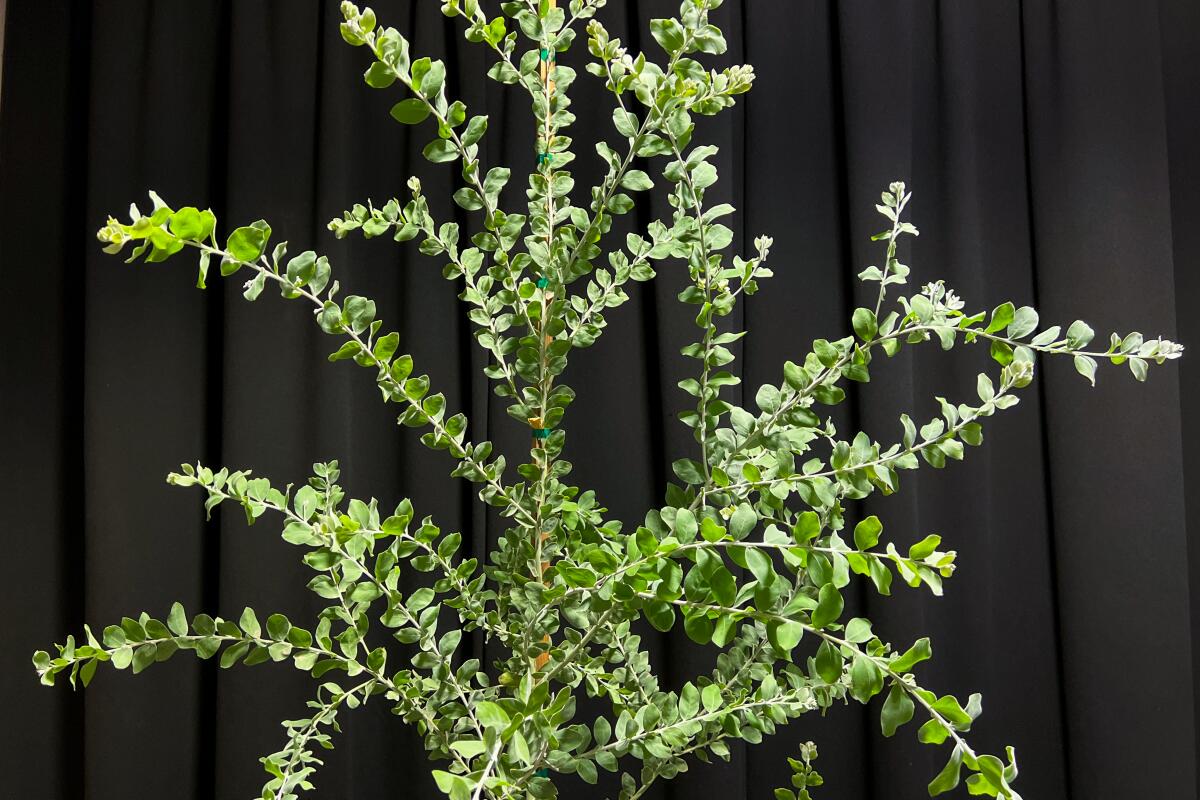
- Pearl acacia: El Nativo Growers in Azusa is one of the biggest native plant wholesalers in the state, so I was surprised to see them promoting this airy pearl acacia tree from Australia. But sales rep Caitlin Irwin said this graceful tree is a natural fit with their California native offerings. “These are plants that are climate friendly, drought tolerant and don’t mind our soils,” she said, “And they have these nice yellow pom pom blooms in the winter so they give you some color when few other things are blooming.” The tree grows to around 12 feet tall, she said, but starts blooming when it’s 3 feet tall, making it an excellent choice for patio containers.
They renovated their Los Angeles yard with climate change in mind. Then they got derailed by a Nextdoor complaint and a city notice.
Finally, before we move on to events, I’d like to thank you for subscribing to the L.A. Times Plants Newsletter — nearly 10,000 of you since we started in June! — and encourage you to send story ideas to [email protected].
I wish you the best the holidays offer — sparkly lights, delicious foods, beautiful music, and, most importantly, the company of beloved family and friends.
Consider subscribing to the Los Angeles Times
Your support helps us deliver the news that matters most. Become a subscriber.
Upcoming events
Dec. 2, 5, 6 and 9
Tinyplants’ Succulent Wreath and Topiary Tree Workshops at Growing Works Nursery in Camarillo at 10 a.m. to noon on Dec. 2 and 5, noon to 2 p.m. on Dec. 2 and 9, and 5:30 p.m. on Dec. 6. All materials provided. Tickets range from $45 for a 9-inch Christmas tree ($25 if made by children 12 and younger) to $55 for an 11-inch wreath ($35 if made by children 12 and younger). tinyplants.biz
Dec. 2 and 23
Growing Works Nursery native plants and succulents sale, 10 a.m. to 2 p.m. each day at the normally wholesale nursery in Camarillo. turningpointfoundation.org
Dec. 2
Fruitstitute Citrus Tree Pruning 101 from 10:30 a.m. to 1:30 p.m. at Franklin Canyon Orange Grove in Beverly Hills. Learn how to improve the health and productivity of backyard citrus trees. Tickets are $50; advance registration is required. laparksfoundation.org
Native Plant Wreath Workshop taught by Golden Heron flower farmer Hannah Melde-Webster from noon to 2:30 p.m. at the farm. All materials are provided, but participants are encouraged to bring natural materials special to them, such as pine cones, shells with holes or feathers. Tickets are $100. usalproject.com
Introduction to Landscape Renovation for Waterwise Home Gardens, a free workshop from 9 to 11:30 a.m. at the Chino Basin Water Conservation District’s Waterwise Community Center in Montclair. cbwcd.org
Apricot Lane Farms presents the Art of Compost, workshops about the farm’s approach to soil fertility, composting, vermiculture and compost tea, 8 a.m. to noon or 1 to 5 p.m. at the farm in Moorpark. Advance registration is required, $200. eventbrite.com
Worm composting, or vermicomposting, turns food waste into worm castings that are great for garden soil. Here’s how to start worm composting at home.
Invasive Plant Foraging Walk and Salad Party, an easy, 2-mile walk through Elysian Park with certified naturalist Jason “Journeyman” Wise, from 10 a.m. to noon to learn about native and invasive plants growing at the park, which are edible and how to create a “wild foraged, hyper-locally sourced salad.” Participants will receive Wise’s Plant ID and recipe guide. Tickets are $20. eventbrite.com
Natural History Walk at Taft Gardens and Nature Preserve 10 a.m. to noon in Ojai. Author and naturalist Lanny Kaufer will lead participants through the wild parts of the preserve, identifying native plants and herbs as well as birds and animal tracks. Tickets are $35, with $10 going to benefit the Conservation Endowment Fund (CEF), the nonprofit steward of Taft Gardens. taftgardens.org
Monarch Nature Trail Volunteer Day is open to all ages who want to weed, mulch and otherwise help restore the nature trail for butterflies from 9 to 11 a.m. in Huntington Beach. No reservations needed; participants should wear tennis shoes, bring drinking water, and wear sun protection. Note that the site has no restrooms. mgorange.ucanr.edu
Dec. 3
Learn to Grow Sweet Peas with Joan Stevens of Mama Botanica flower farm, from 11 a.m. to noon at Fig Earth Supply in Mount Washington. Tickets are $10. figearthsupply.com
Finding Our Way Home With Fungi, a Theodore Payne Foundation walk and talk with mycologist Aaron Tupac, 11 a.m. to 1 p.m. at the Altadena Trailhead, involves information about mushrooms and their relationship to other living things during a two-mile walk on an unpaved easy/moderate path in Altadena. Tickets are $35 ($25 for foundation members, free for children under 12). eventbrite.com
Dec. 8, 12 and 18
Holiday Succulent Wreath Workshops by Soulful Succulents from 6 to 7:30 p.m. at Trademark Brewing in Long Beach on Dec. 8, 5:30 to 7 p.m. at the Better Half Boutique in Long Beach on Dec. 12, and 7 to 8:30 p.m. at Bootlegger’s Brewery Tasting Room in Fullerton on Dec. 18. Prices range between $50 to $60 depending on the size of the wreath. All materials are included. eventbrite.com
Dec. 9
Herb Walk led by Herb Club L.A. founder and certified naturalist Andrea Jimenez from 11 a.m. to 1 p.m. in Los Angeles. Participants will learn how to identify plants and their medicinal uses and more. Tickets are $35. usalproject.com
Favorite California Native or Waterwise Plants for Southern California Gardens, a free workshop from 9 a.m. to noon at the Chino Basin Water Conservation District’s Waterwise Community Center in Montclair. cbwcd.org
One of the best ways to learn more about plants is to volunteer at Los Angeles area nurseries, botanic gardens, nature groups and plant advocacy organizations.
Birding in the Garden: An Experiential Walk and Talk with environmental scientist and birder Diego Blanco, who explains which birds are year-round residents, which are seasonal visitors, and their primary food sources, from 8:30 to 10:30 a.m. in the gardens of the Theodore Payne Foundation in Sun Valley. Tickets are $25 ($20 for members). eventbrite.com
Natural Birdhouse Making With Gourds taught by artist and landscape designer Leigh Adams from 11:30 a.m. to 2:30 p.m. at the Theodore Payne Foundation in Sun Valley. All materials provided. Open to participants 8 and older. Tickets are $60 ($50 for members). eventbrite.com
Dec. 10
Queer Ecology walk with Jason “Journeyman” Wise, a certified California naturalist and outdoor educator, who leads participants on an easy, two-mile hike in Griffith Park from 11 a.m. to 1 p.m. December’s hike will focus on the ways our holidays are rooted in nature with mistletoe, toyon (California holly), pine trees and (rein)deer. Advance registration is required. Tickets are $10, or free to those who can’t afford to pay. eventbrite.com
Dec. 12
TreePeople 50th Anniversary tree planting in Colton at Elizabeth Davis Park, a celebration that will involve planting 50 trees at the park along with talks about how shade trees benefit our communities and the environment. TreePeople also has several other tree plantings in other communities this month, including South Gate on Dec. 2, 9 and 22; Paramount on Dec. 7, 16 and 30; Inglewood on Dec. 15 and 29; Huntington Park on Dec. 18, Green Valley on Dec. 18, and Northridge Middle School on Dec. 11. treepeople.org
Dec. 14
“Avocados: Their Natural History and How to Grow Them,” a talk by Eric Focht, avocado researcher and breeder at UC Riverside, at 7:30 p.m. in the Friendship Auditorium in Griffith Park during the Southern California Horticultural Society monthly meeting, holiday potluck and plant sale of cool-season veggie seedlings grown by master gardener and Gardening in LA blogger Yvonne Savio. Admission is free for members, $5 for guests. socalhort.org
California Native Plant Container Gardening with Flora Ito, manager of the Theodore Payne Foundation native plant nursery, 9 to 10:30 a.m. at the nursery in Sun Valley. Tickets are $25 ($20 for members). event.brite.com
Dec. 16
Natural Plant Dye Workshop 1 to 3:30 p.m. at the Theodore Payne Foundation in Sun Valley. Artist and illustrator Carly Lake explains how to use native and invasive plants to create natural dyes for silk bandannas and scarves. All materials provided. Open to participants 7 and older. Tickets are $80 ($70 for members). eventbrite.com
Holiday Nature Hike from noon to 2 p.m. at Griffith Park. Certified naturalist and outdoor educator Jason “Journeyman” Wise will lead participants on a one-mile hike to point out native plants along the route, and forage items such as mistletoe, red toyon berries and pine cones to make into holiday ornaments after the hike. Open to all ages and warm apple cider will be provided. Tickets are $30 usalproject.com
After feeling unfulfilled as a music talent manager, Michael Washington immersed himself in the outdoors and launched USAL Project, which has become a cool kids nature club.
Dec. 17
Holiday Succulent Star Wreaths, a workshop taught by Hue the Muse and Tansy store owner Colette Rounsavall Fowler at the store in Burbank. Learn how to make a 10-inch living succulent star wreath that can be used as a tree topper. All materials are included. Tickets are $55. eventbrite.com
Learn to Grow Winter Bulbs such as freesia, narcissus and tulips with Joan Stevens of Mama Botanica flower farm, from 11 a.m. to noon at Fig Earth Supply in Mount Washington. Tickets are $10. figearthsupply.com
Dec. 23
Sustainable Gift Wrapping Workshop, 10 a.m. to noon at Growing Works Nursery in Camarillo. Michelle Stevens, CEO and founder of the Refill Shoppe in Ventura, explains how to use dried plants and other compostable materials to wrap holiday gifts. All materials are provided. Tickets are $18. eventbrite.com
What we’re reading
Who knew that Baja California’s Valle de Guadalupe is now considered premiere wine country? Lots of tourists, apparently, and therein lies the problem.
In the good news/bad news department, endangered sea turtles have broken egg-laying records this year on beaches in Florida and other states, but when you consider climate-change-driven issues like rising water temperatures and catastrophic hurricanes, and data that indicates only 1 of every 1,000 sea-turtle hatchlings make it to adulthood, it’s hard to celebrate.
Struggling with the holiday blues? Photographers Mel Melcon and Kelvin Kuo have the perfect remedy with their grin-inducing story about Idyllwild’s handsome, furry Mayor Max in “the unusual story of how a dog became a town’s mayor.”
If you like getting dirty, here’s a list of 18 places to learn about plants while volunteering around Los Angeles.
OK, it’s not really a tree, but when I was a kid it sure felt real to me. Check out our theme park guru Todd Martens’ reveal of how Disneyland revitalized one of its most underrated attractions.
There are gorgeous photos of New Zealand’s incredible countryside here, but if you, like me, are a die-hard fan of Peter Jackson’s “Lord of the Rings” trilogy, this story about how the blockbuster movies transformed his mother country is a must read.
What’s better than sex and weed? Don’t think too hard ... just read Adam Tschorn’s delightful dive into West Hollywood’s new cannabis lounge/bar/restaurant and “pleasure campus.”
While we’re talking about Adam, don’t miss his deep dive into the 32 best places in Southern California to make December’s premiere plant purchase.
Annnd if you want to add a little razzle-dazzle to your December nights, here’s a list of 30 places to find holiday light shows in Southern California.
Sign up for The Wild
We’ll help you find the best places to hike, bike and run, as well as the perfect silent spots for meditation and yoga.
You may occasionally receive promotional content from the Los Angeles Times.
